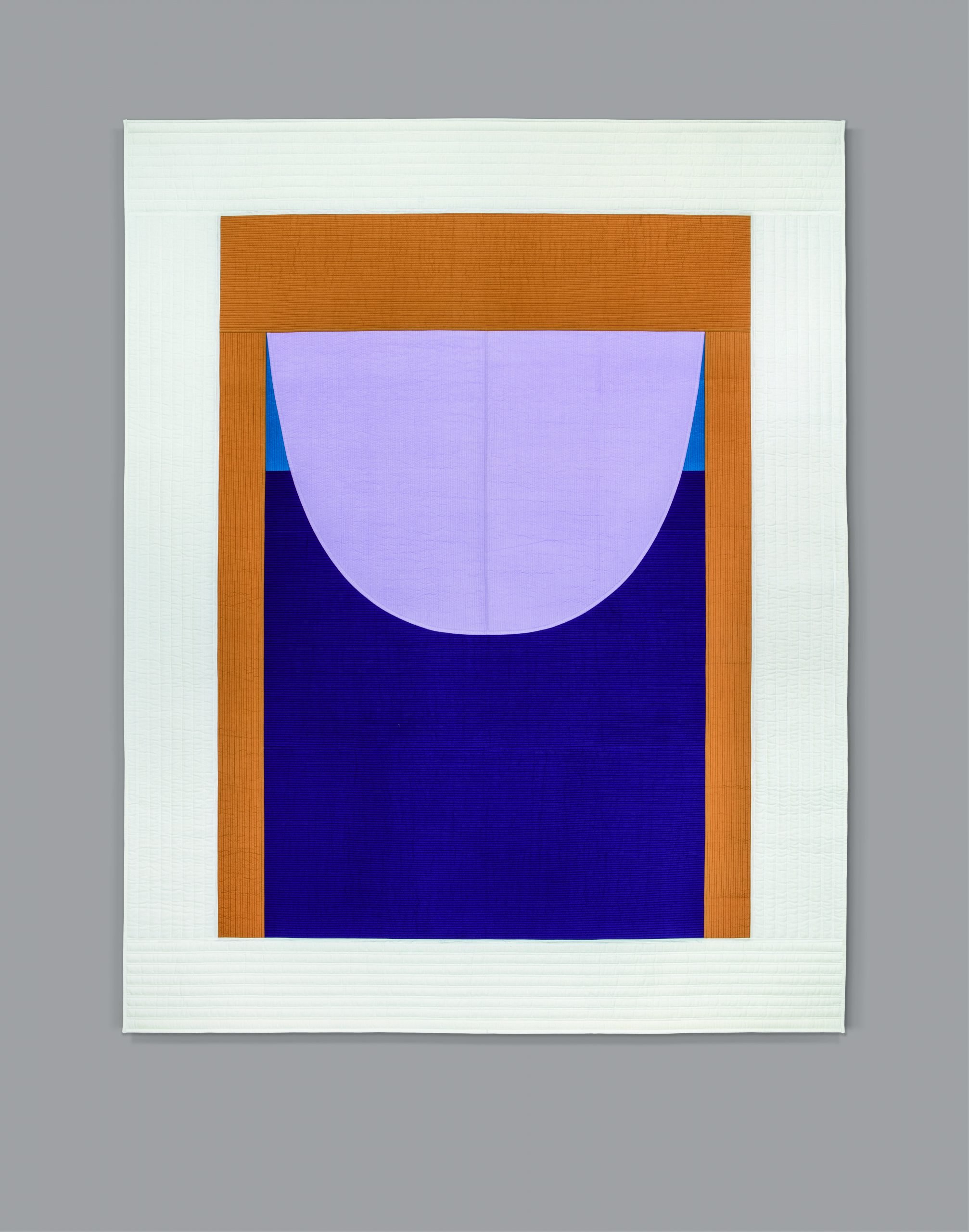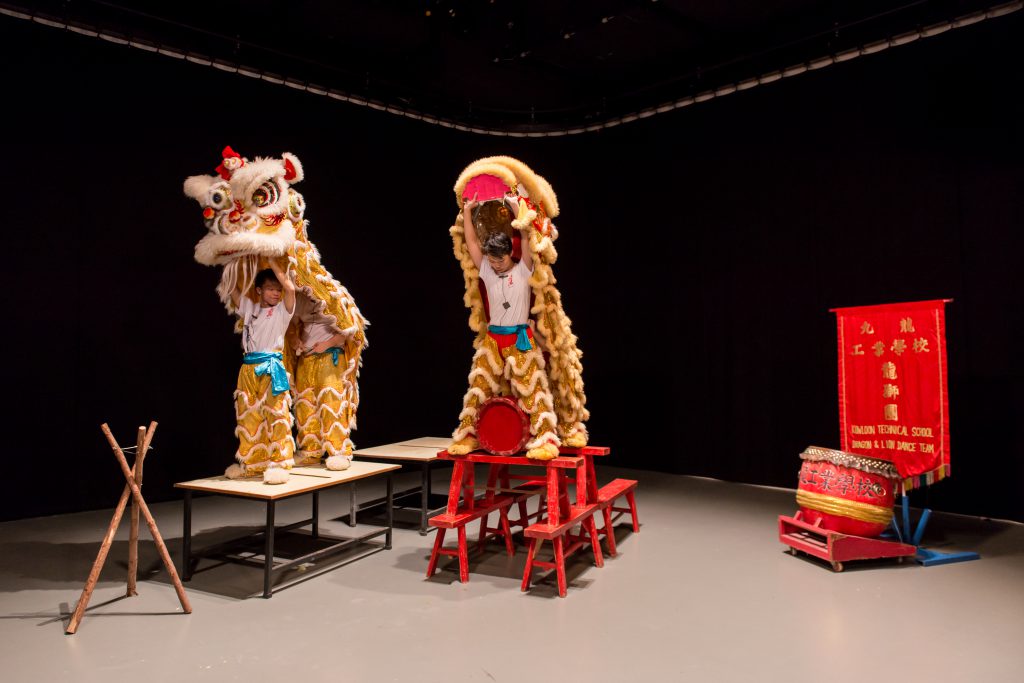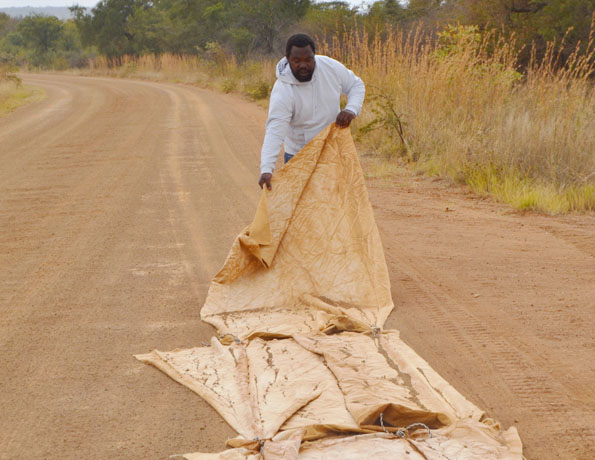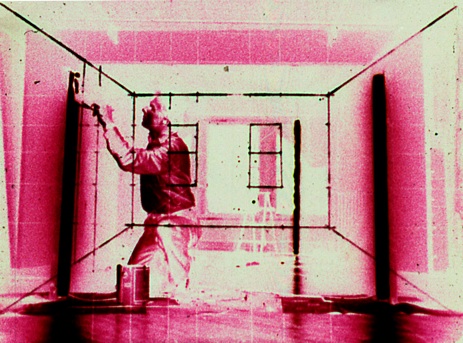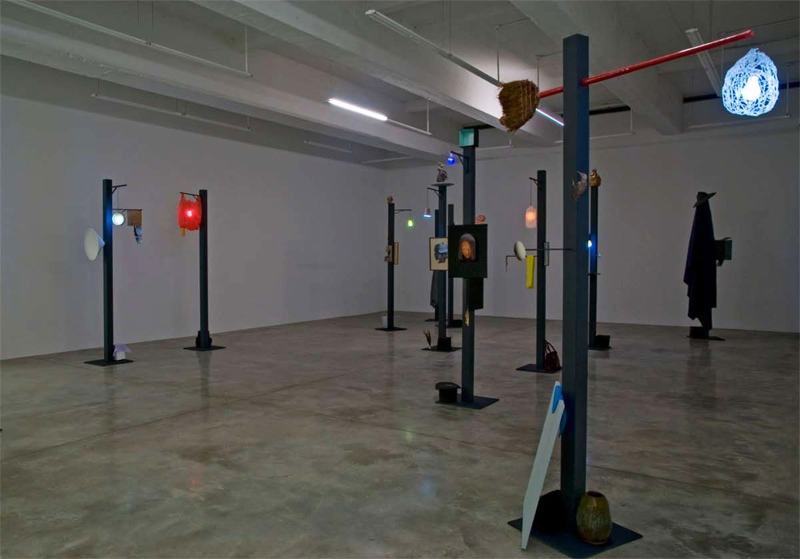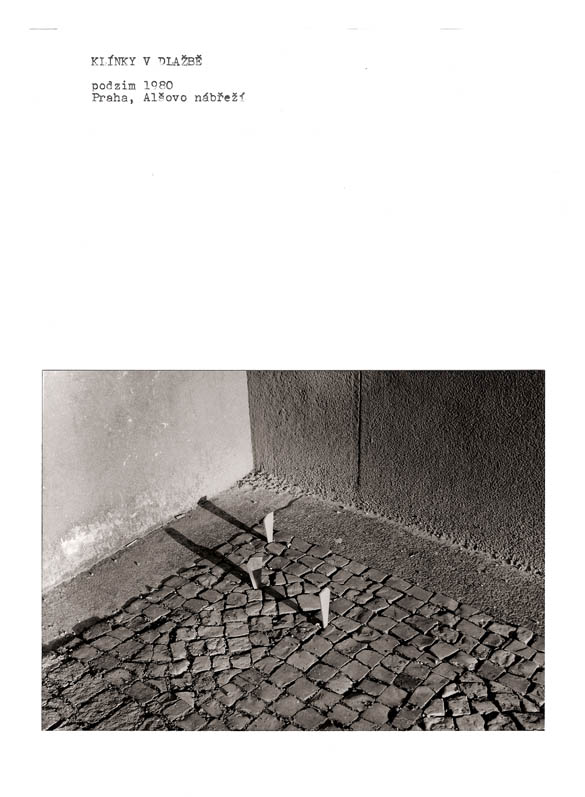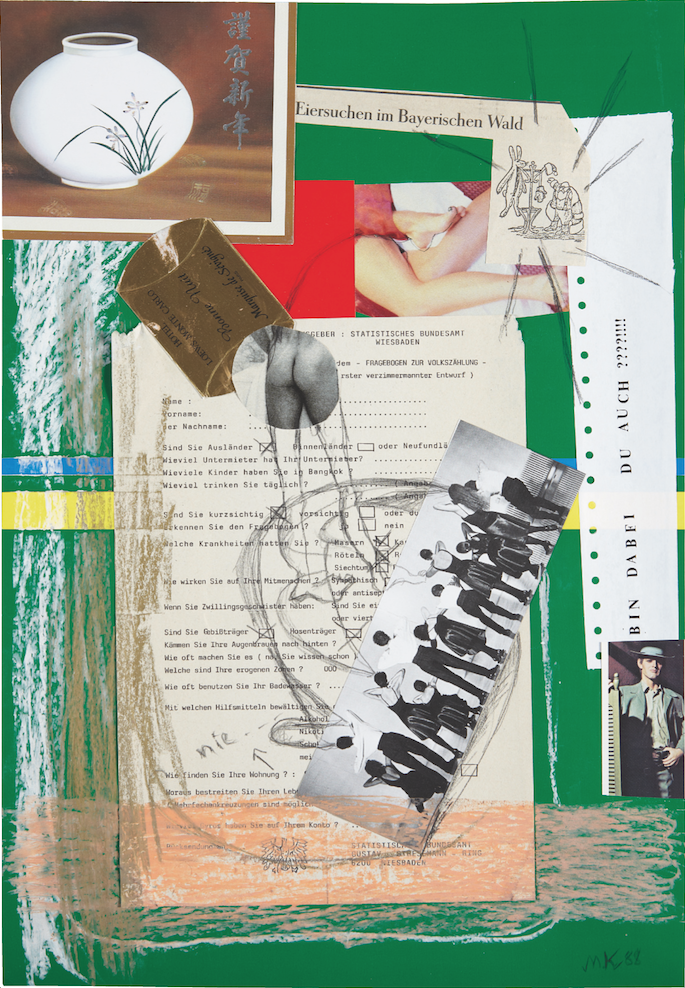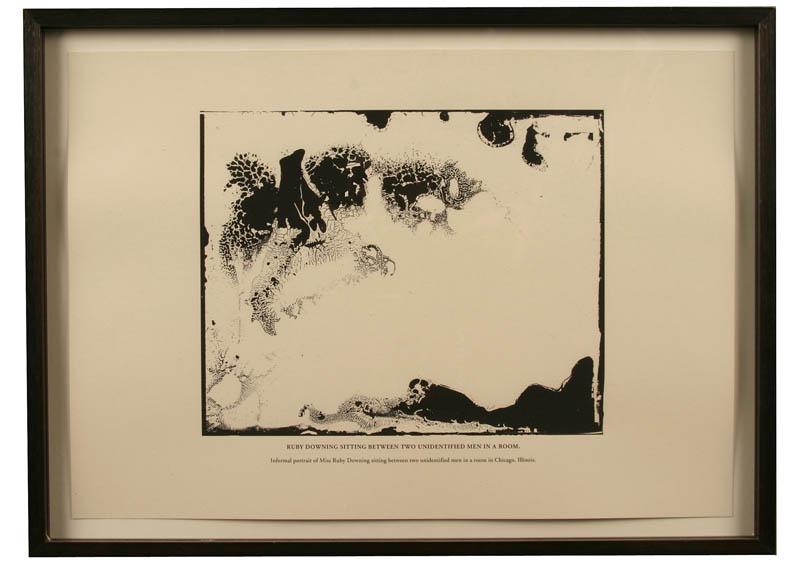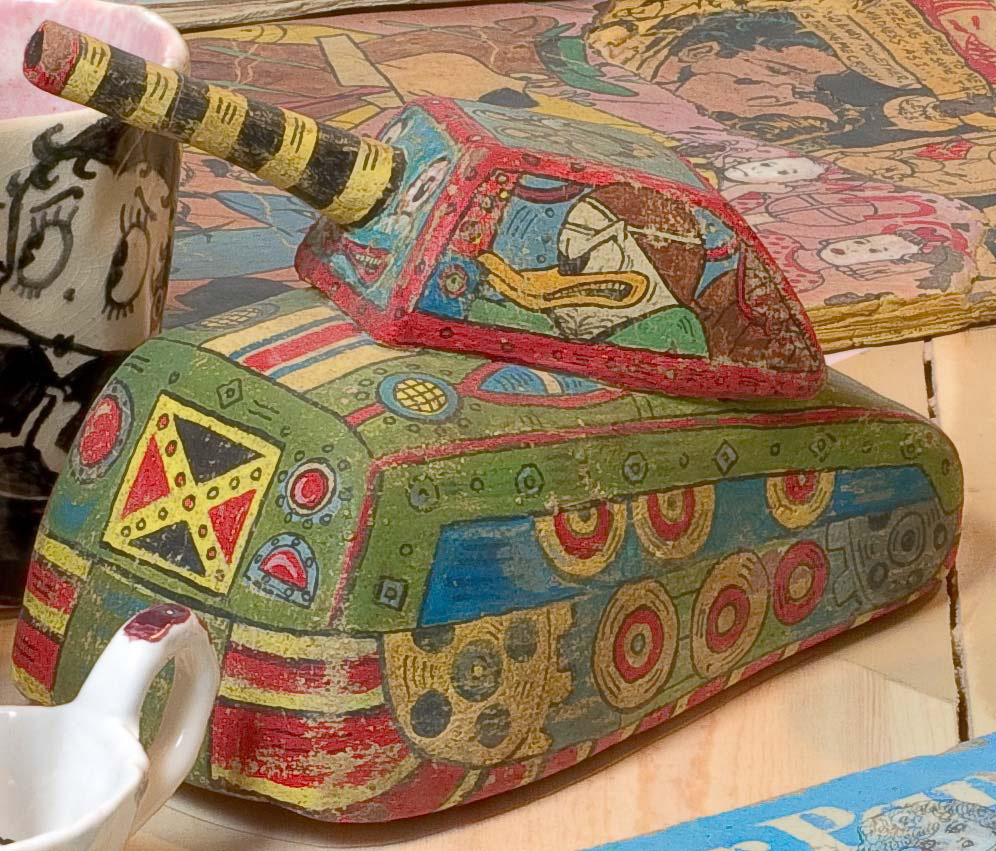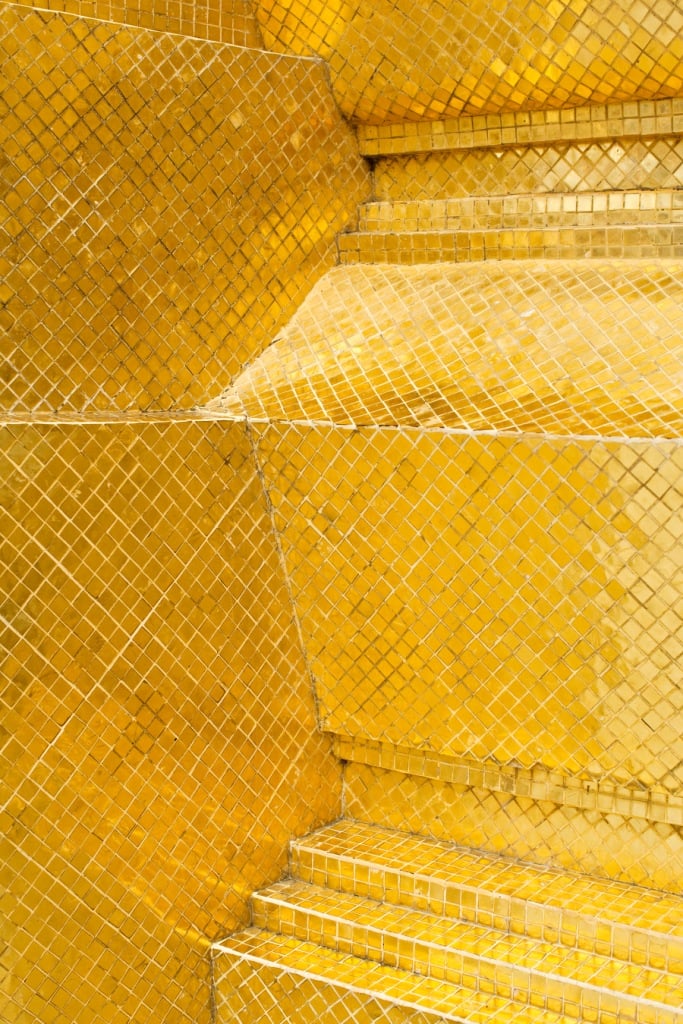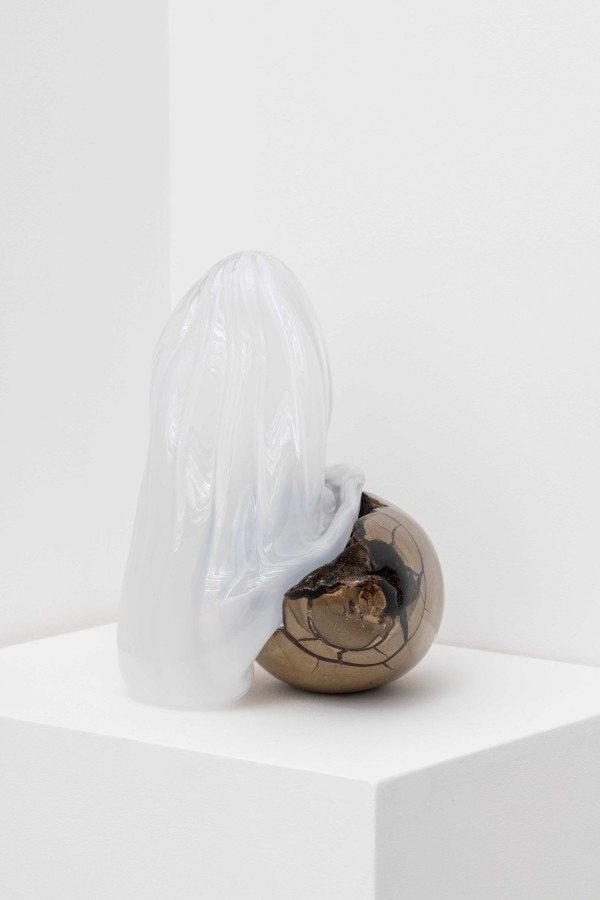
© » KADIST
Phoebe Collings-James
The Subtle Rules the Dense is a series of masks/torsos/body plates that Phoebe Collings-James cast from mannequins and then worked by hand. The resulting objects lie ambiguously between a representation of a human torso and a shamanistic mask. The work is reminiscent of Yoruba and Makonde body masks that portray pregnant forms, as well as Roman armor with nipple rings.

© » KADIST
Egle Jauncems
The title of this work by Egle Jauncems, The Paler King I , is taken from an unfinished novel by the late David Foster Wallace called The Pale King, published posthumously in 2015. Jauncems notes that the book is fragmented, following unrelated characters struggling with ennui and depression, navigating the pressures of modern reality. In her art practice, Jauncems has been interested in the lives of powerful and influential men for many years.

© » KADIST
Fernanda Laguna
Llorar mucho (To Cry A Lot) is representative of Fernanda Laguna’s practice of the past twenty years. It is an upshot of intense emotional stress and psychological regression for the artist, which resulted in her renewed and strengthened commitment to feminist causes, especially in Villa Fiorito, but also as part of the leading committee of Ni Una Menos in Argentina. It also picks up the thread of earlier works, accentuating the use of cotton, and embracing an almost cornily sentimental tone.

© » KADIST
Nontawat Numbenchapol
The series of prints titled Mr. Shadow by Nontawat Numbenchapol engages with the history of and current state of militarization in Thailand. Each print features an invisible person, their silhouette only outlined by the military fatigues that they wear.

© » KADIST
Fernanda Laguna
¡Qué triste estoy! (I’m So Sad) is representative of Fernanda Laguna’s practice of the past twenty years. It is an upshot of intense emotional stress and psychological regression for the artist, which resulted in her renewed and strengthened commitment to feminist causes, especially in Villa Fiorito, but also as part of the leading committee of Ni Una Menos in Argentina.

© » KADIST
Pichet Piaklin
The Wings by Pichet Piaklin is a creation story of fragility, where the desire for freedom is mired in blood red by the inculcation of faith and violence. Piaklin was born and continues to live and work in Thailand’s deep south, a geographical area once known as the Pattani Kingdom (now the Pattani, Yala, and Narathiwat provinces), before it was annexed by the Siam Kingdom in the early 1900s. As a consequence of unreconciled historical conflict, this predominantly Muslim community continues to endure oppressive social and political conditions under the ruling Thai Buddhist monarchy.

© » KADIST
Naama Tsabar
Naama Tsabar’s sculptural works are developed serially. The series Work on Felt references the history of post-minimal sculpture: from Robert Morris to Joseph Beuys’s social sculptures. However one can equally relate her work to 1970s conceptual performers such as Terry Fox or Paul Kos.

© » KADIST
Nikita Gale
RUINER III by Nikita Gale is part of an on-going numbered series of abstract sculptures in which various ancillary materials necessary for sound production and recording such as towels, foam, and audio cables, are riddled around piping resembling crowd control bollards, lighting trusses, and other like stage architecture. While these muscular works evoke the forms and dynamism of mid-century modernism, they can also be seen as a translation of Goethe’s idea that “architecture is frozen music”. RUINER III is exemplary of how the artist’s disembodied sets typically evoke a sense of longing through absence, and in so doing, draw out an extended mediation on how audiences project mental or emotional energy onto a person, object, or idea.

© » KADIST
Nontawat Numbenchapol
The series of prints titled Mr. Shadow by Nontawat Numbenchapol engages with the history of and current state of militarization in Thailand. Each print features an invisible person, their silhouette only outlined by the military fatigues that they wear.

© » KADIST
Zhu Changquan
In Dark Beyond Deep by Zhu Changquan the film presents the process of how consciousness gradually develops and extends from the real world to virtual space through a raven named Cyma. Cyma redefined things in the “digital garden” in the film by comparing them with the logic in reality. It opened a new passage for mutual reflection between objects in real life and the existence of digital objects in digital space.

© » KADIST
Minia Biabiany
Qui vivra verra, Qui mourra saura is an installation by Minia Biabiany composed of the plan of a house made out of strips of salt, and a “garden” made of ceramic pieces, hanging from the ceiling and on the floor, and non woven fabric. She uses blue and red filters to alter the hues of light coming from the outside. The work focuses on the disappearance of traditional knowledge associated with the “jardin de case” outside Guadeloupean houses.

© » KADIST
Sandra Monterroso
Drawing & Print (Drawing & Print)
Presented as part of a recent group of works titled The Paradox of Healing, Rhombus for Healing No. 2 by Sandra Monterroso brings together several of the artist’s interests: the use of ritual and medicinal elements; the conciliation of Western and indigenous formal languages; and more recently, sewing as a recognition and celebration of her maternal lineage. The series as a whole and this painting in particular continue her interest in textiles as visual references and cultural tools to address her native Guatemala’s complex political and cultural histories.
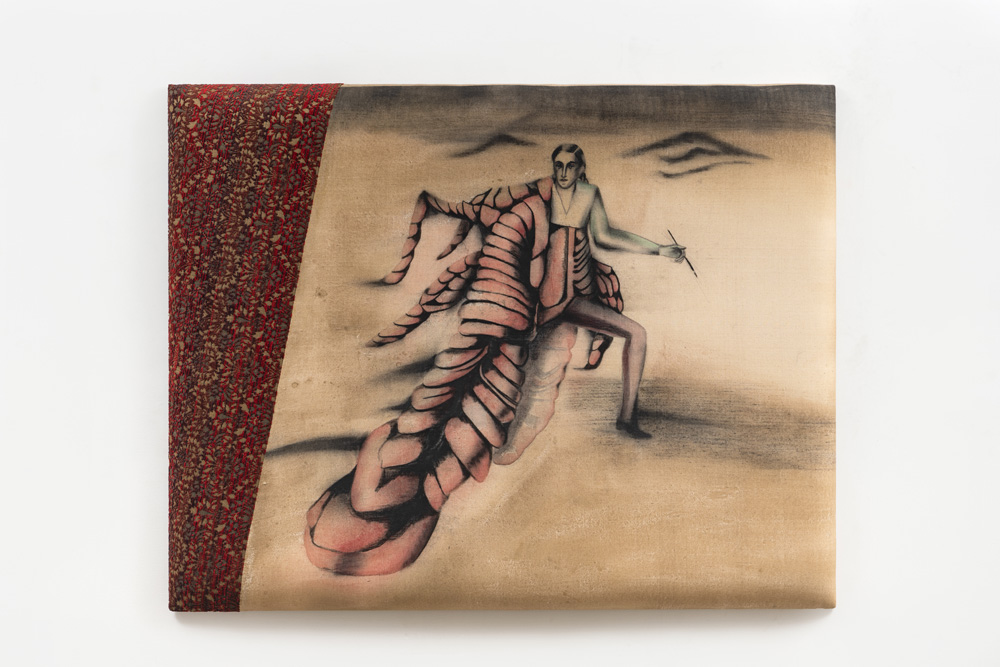
© » KADIST
Anju Dodiya
The Shedding by Anju Dodiya is part of a series of mattress paintings the artist creates using fabric stretched on padded and shaped boards. The imagery relates to other paintings in this body work that expresses the visceral and vulnerable side of creativity. The posture of the protagonist—a part-human, part-carapaced animal—is opening herself outwardly.

© » KADIST
Yu Ji
Flesh in Stone – Ghost No. 1 is a stunning series of cement made body parts in various scales and movements, along with components such as iron and plaster molds to emphasize their tension. The “incompleteness” of Flesh in Stone weakens the figurative image itself, thus shifting the viewer’s focus onto the relationship between the rough material and the ideal rounded body shapes.

© » KADIST
James Collins
These two large format untitled paintings by James Collins feature the artist’s hallmark technique, which transforms abstraction into an optical illusion that creates dimension, space, and mass. These particular paintings expand on the optical illusion referred to as a moiré pattern. Moiré (or fringe patterns as they are also called) are known in mathematics, physics, and art as a type of interference pattern that can be produced when a partially opaque ruled pattern with transparent gaps is overlaid on another similar pattern.

© » KADIST
Cross Lypka
tombs and ignitions is a collaborative ceramic sculpture by artists Tyler Cross and Kyle Lypka. The work was translated by Kyle Lypka from Tyler Cross’s original drawing into three dimensions by coil building upwards. Lypka chose to coil build instead of using slabs because, although very flat and geometric, he believed that the form would benefit from the more organic technique of coil building, which after drying and firing tends to twist and pull, adding a sort of paradoxical swing and motion to the work’s angularity.

© » KADIST
Diane Severin Nguyen
To produce her photo and film works, Diane Severin Nguyen makes amalgam sculptures from found materials, both natural and synthetic. She captures these ephemeral constructions at close range, enlarging minute tensions. Nguyen uses transient, prosthetic lighting—the glow of sunset, an iPhone flash, battery-powered LEDs, fire—so that the camera intervenes moments before these temporary arrangements and their lighting change.

© » KADIST
Fernando Palma Rodríguez
Aqua by Fernando Palma Rodríguez is an installation formed by four gourds and one movement detector that activates them. Once put in motion, the gourds open and close hinged hands that are cut from their bodies, catalyzing a sophisticated, choreographed conversation among them. Following Indigenous notions of personhood, Palma Rodríguez grants agency to ordinary objects and therefore the ability to relate to others—humans as well as non-humans.
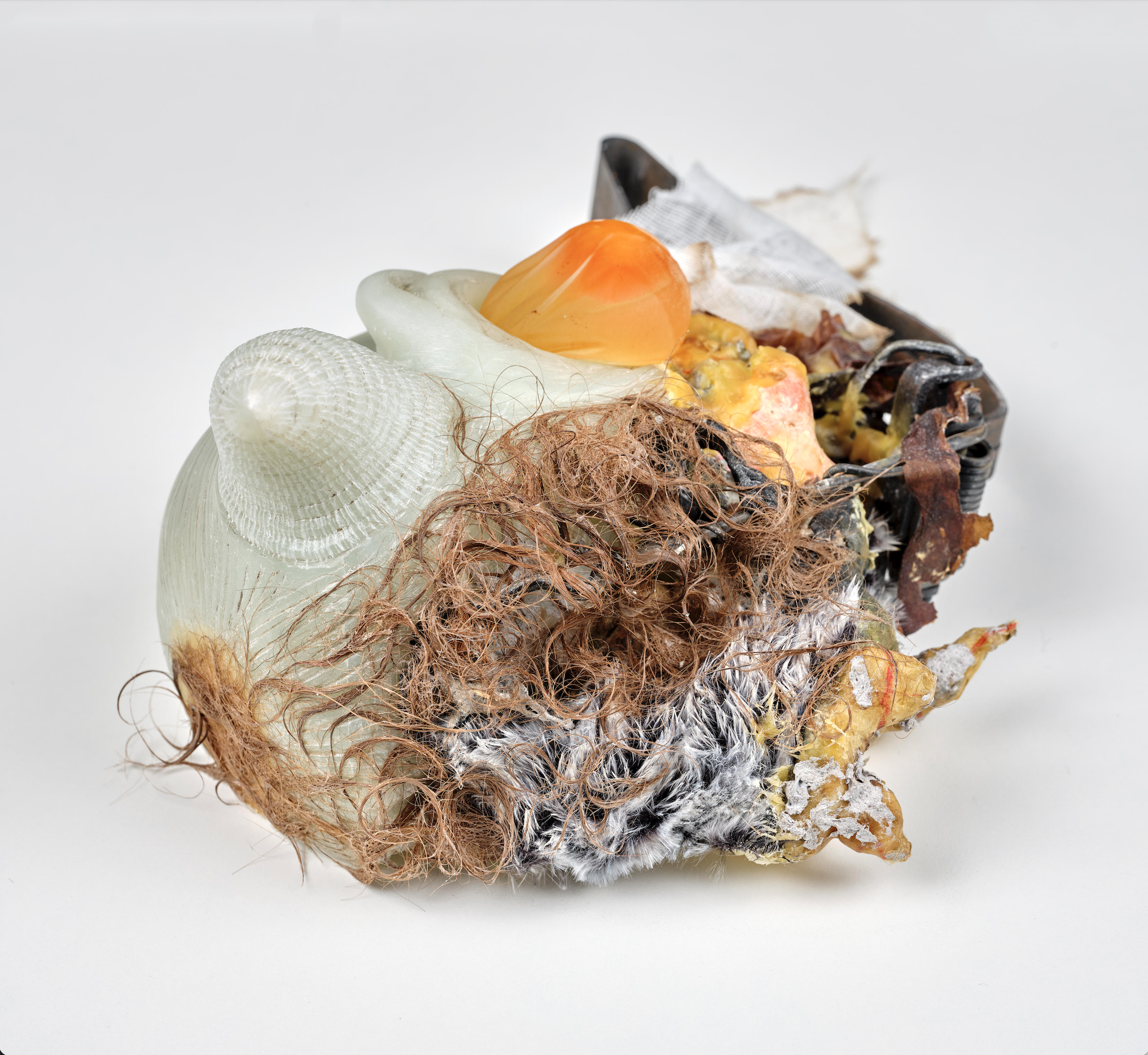
© » KADIST
Catalina Ouyang
font VII by Catalina Ouyang is part of an ongoing series of ‘fonts’, or sculptures, inspired by Catholic holy water vessels. This particular iteration from the series combines hand-carved soapstone, a stop loss trap, horse hair, fermented egg, and other elements to create an artwork that defies categorization. The work’s most notable feature is a small cavity that cradles a naked egg—a translucent, flaccid egg without its outer shell.

© » KADIST
Jiri Kovanda
Kovanda’s street interventions are always documented according to the same format as the actions: a piece of A4 paper, a typewritten text giving a precise location and date, and a photograph. Contrarily to the actions, he took the photographs himself. One of the rules he stuck to in his artistic practice was to always use material at his disposal, a real economy of means.

© » KADIST
Mithu Sen
home, a temporary place by Mithu Sen is part of a project called AºVOID. In this fragmented mental map, the landscape is fleeting, embossed, and ethereal; there are moments of recognition and also a near-violent sudden emptying of memory. Bodies are skeletal, nature is in entropy, context is removed.

© » KADIST
Risham Syed
Risham Syed discovered a box of woven Chinese silk panels that was her mother’s most prized possession. Her mother had long talked about making quilts with these panels; there were many questions about what she would do with so many panels, which were ultimately used to compose Risham Syed’s work Ali Trade Center Series IV (with Buddleia) . After her mother’s death, Syed began to explore the history of this fabric as a material linked to commerce, power, social class, and culture, and thus linked to a history of violence, hardship, upheaval, and conflict.

© » KADIST
Vaclav Pozarek
Concerning his objects, Pozarek often relies on chance to guide him. He uses scraps of wood, boxes, hinges and doors, keeping a close eye on what position each object will assume later in the space. Although it suggests the opposite at first glance, Zwillinge is autonomous and functionless.

© » KADIST
Laura Gannon
The impressionistic surface of Wild Money (2017) recalls the 1950s paintings of Philip Guston. Its creases recall human skin, while the filigree pattern of red skeins implies what lies beneath. The body is fully implicated in this work.
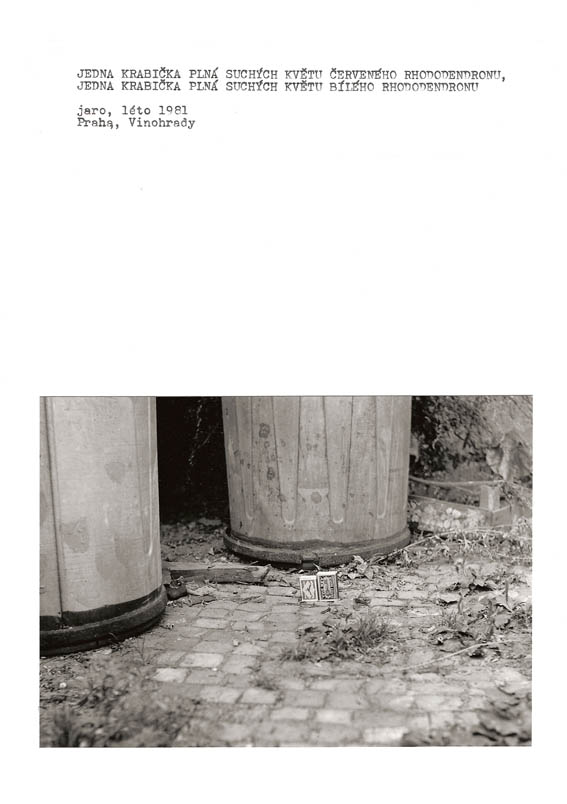
© » KADIST
Jiri Kovanda
Kovanda’s street interventions are always documented according to the same format as the actions: a piece of A4 paper, a typewritten text giving a precise location and date, and a photograph. Contrarily to the actions, he took the photographs himself. One of the rules he stuck to in his artistic practice was to always use material at his disposal, a real economy of means.

© » KADIST
Baseera Khan
Designed by the artist and fabricated in collaboration with Kashmiri artisans in India, Baseera Khan’s Psychedelic Prayer Rugs combine visual iconography traditional to Islam, such as the crescent moon and lunar calendar, with brightly coloured symbols of personal significance to the artist: a pair of embroidered sneakers, a fragment of an Urdu poem, and the Purple Heart medal. Visually seductive yet charged with political and symbolic associations, the rugs bridge elements of American popular culture with aspects of Islamic worship that may be misunderstood in contemporary secular contexts. Encouraged by Khan to take their shoes off and interact with the rugs, viewers participate in a decolonizing process as they meditate on their poetic allusions or perform the traditional salat, the daily prayers that constitute one of the five pillars of Islam, the others being faith, charity, fasting, and pilgrimage to Mecca.

© » KADIST
Kadar Brock
Kadar Brock creates dynamic abstract paintings that are born from a process of painting, scraping, priming, sanding, and painting again. Retaining a commitment to his established process, Brock layers paintings about personal memory, family history, and iconographies of New Age religion, alongside representations of masculinities found in the characters of American and Japanese comic books and film. The physical and emotional process of creation, often taking place over many years, enables a reverse archaeology of the self and renders a delicate balance between body, memory, and psychology.

© » KADIST
Baseera Khan
Designed by the artist and fabricated in collaboration with Kashmiri artisans in India, Baseera Khan’s Psychedelic Prayer Rugs combine visual iconography traditional to Islam, such as the crescent moon and lunar calendar, with brightly coloured symbols of personal significance to the artist: a pair of embroidered sneakers, a fragment of an Urdu poem, and the Purple Heart medal. Visually seductive yet charged with political and symbolic associations, the rugs bridge elements of American popular culture with aspects of Islamic worship that may be poorly understood in contemporary secular contexts. Encouraged by Khan to take their shoes off and interact with the rugs, viewers participate in a decolonizing process as they meditate on their poetic allusions or perform the traditional salat, the daily prayers that constitute one of the five pillars of Islam, the others being faith, charity, fasting, and pilgrimage to Mecca.
Gozo Yoshimasu
Gozo Yoshimasu is a prolific Japanese poet, photographer, artist and filmmaker active since the 1960s...
Lisa Oppenheim
- location: New York, New York
- year born: 1975
- gender: female
- nationality: American
- home town: New York, New York
Jiri Kovanda
- location: Praha, Ceská Republika
- year born: 1953
- gender: male
- nationality: Czech
Nontawat Numbenchapol
Nontawat Numbenchapol is primarily known as a film director and television screenwriter, widely recognized for his documentary work...
Sheroanawe Hakihiiwe
Sheroanawe Hakihiiwe is a Yanomami artist who lives and works in Upper Orinoco, at the Venezuelan side of the Amazon rainforest...
James Welling
- location: New York, New York; Los Angeles, California
- year born: 1951
- gender: male
- nationality: American
- home town: Hartford, Connecticut
Baseera Khan
Designed by the artist and fabricated in collaboration with Kashmiri artisans, Baseera Khan’s Psychedelic Prayer Rugs combine visual iconography traditional to Islam, such as the crescent moon and lunar calendar, with brightly colored symbols of personal significance to the artist: a pair of embroidered sneakers, a fragment of an Urdu poem, and the Purple Heart medal...
Fernanda Laguna
Fernanda Laguna has mobilized and influenced a whole generation of artists through her various projects since the mid-1990s...
Mary Ann Aitken
Mary Ann Aitken was known to be very private about her art practice; she was considered somewhat of an outsider by her peers affiliated with the second wave of Detroit’s Cass Corridor arts movement...
Mithu Sen
Mithu Sen’s writing is central to her practice, as a poet from West Bengal, a region of great Indian literary history, poetic and visual tropes giving ground to her challenge of semiotics...
Sandra Monterroso
Sandra Monterroso is a Guatemalan artist of Maya Q’eqchi’ decent...
Diane Severin Nguyen
Diane Severin Nguyen collects found objects and organic matter to craft the images in her photographs and video works...
David Haxton
Although trained as a painter, David Haxton is known for his exploration of light through the mediums of photography and film...
Martin Creed
- location: Wakefield, United Kingdom
- year born: 1968
- gender: male
- nationality: British
Martin Kippenberger
- location: Vienna, Austria
- year born: 1953
- gender: male
- nationality: German
- home town: Dortmund, Germany
Egle Jauncems
Egle Jauncems’s practice considers the relationship between painting and textile art...
Risham Syed
Risham Syed has a diverse art practice in which painting and other mediums are used to explore issues of history, sociology, and politics...
Seulgi Lee
Seulgi Lee’s artistic references range from anthropological materials, archetypical linguistic elements, vernacular culture, handcrafts tradition, to the graphic culture of animistic belief found in diverse locals around the world...
Yuyan Wang
Yuyan Wang is a filmmaker and multidisciplinary artist whose work examines images at the point of production and the atmosphere cultivated by media regimes within the attention economy...
Phi Phi Oanh
Phi Phi Oanh’s unique practice and methodology is anchored in the study of lacquer and pushes the boundaries of the material as a sculptural and conceptual form...
Pichet Piaklin
Pichet Piaklin is an artist and teacher, whose commitment and belief in art saw him establish the Faculty of Fine and Applied Arts at the Prince of Songkhla University in Pattani, in Thailand’s deep south...
Minia Biabiany
Minia Biabiany’s practice is concerned with the past and ongoing effects of colonialism, exploring the poetics of resistance embedded in everyday life practices, and translating this research into the exhibition space through careful consideration of the cultural and spiritual implications of the material she uses, and the techniques she employs...
Cici Wu
Beijing-born artist Cici Wu is a cultural nomad whose work takes on unusual forms, from functional sculptures to haphazard installations featuring delicate jerry-rigged parts, including for example: a stepper motor, belt, pulley, light sensor, sleeves, silicone, silver chain, dried strawberry leaves, and a video...
Elena Damiani
- location: Copenhagen, Denmark
- location: Lima, Peru
- year born: 1972
- gender: female
- nationality: Peruvian
- home town: Peru
Vaclav Pozarek
Growing up in Czechoslovakia, Vaclav Pozarek experienced political aggression, spying and ludicrous impediments...
Chris Duncan
Chris Duncan employs repetition and accumulation as a basis for experiments in visual and sound-based media...
Yeni Mao
Yeni Mao’s sculptures have a narrative undertone and are frequently autobiographical, with regard to the Canadian Chinese artist’s transnational background...
Santiago Borja
Santiago Borja’s work explores improbable connections between different thought systems, thus emphasizing the cannibalistic nature of modernism, and its inherently esoteric, yet seemingly “rational”, character...
Walead Beshty
- location: Los Angeles, California
- year born: 1976
- gender: male
- home town: London, United Kingdom
-
1970-1979
David Haxton
197016 films is a selection of David Haxton’s single-screen videos, which he began producing in the 1970s as a continuation of some of the conceptual underpinnings of his earlier film installations...
Eleanor Antin
1973Comprised of fifty-one photographic postcards, Antin’s 100 Boots is an epic visual narrative in which 100 black rubber boots stand in for a fictional “hero” making a “trip” from California to New York City...
-
1980-1989
Jiri Kovanda
1980Kovanda’s street interventions are always documented according to the same format as the actions: a piece of A4 paper, a typewritten text giving a precise location and date, and a photograph...
Jiri Kovanda
1980Kovanda’s street interventions are always documented according to the same format as the actions: a piece of A4 paper, a typewritten text giving a precise location and date, and a photograph...
Jiri Kovanda
1980Kovanda’s street interventions are always documented according to the same format as the actions: a piece of A4 paper, a typewritten text giving a precise location and date, and a photograph...
Martin Kippenberger
1988Martin Kippenberger’s late collages are known for incorporating a wide range of materials, from polaroids and magazine clips to hotel stationery, decals, and graphite drawings...
Martin Kippenberger
Drawing & Print
1989(Drawing & Print) Untitled is a work on paper by Martin Kippenberger comprised of several seemingly disparate elements: cut-out images of a group of dancers, a japanese ceramic vase, and a pair of legs, are all combined with gestural, hand-drawn traces and additional elements such as a candy wrapper from a hotel in Monte Carlo and a statistical form from a federal government office in Wiesbaden, Germany...
-
1990-1999
Mike Kelley
1996Towhead n’Ganga, enclosed in darkness, lorded over by the sexualized folded high priestless form reflects many of Kelley’s works, in both its compositional and semantic qualities...
-
2000-2009
Mary Ann Aitken
2002Untitled (Boom Box, Double-Sided) by Mary Ann Aitken is representational painting of a boom box on an unconventionally long canvas painted on both sides, to mimic the scale and appearance of the actual appliance...
Martin Creed
2003This photograph of Martin Creed himself was used as the invitation card for a fundraising auction of works on paper at Christie’s South Kensington in support of Camden Arts Centre’s first year in a refurbished building in 2005...
Lisa Oppenheim
Drawing & Print
2003(Drawing & Print) The Damaged series by Lisa Oppenheim takes a series of selected photographs from the Chicago Daily News (1902 – 1933) as its source material...
Lisa Oppenheim
Drawing & Print
2003(Drawing & Print) The Damaged series by Lisa Oppenheim takes a series of selected photographs from the Chicago Daily News (1902 – 1933) as its source material...
Jonathan Monk
2003Untitled (rolled up) , is an abstract portrait of Owen Monk, the artist’s father and features an aluminum ring of 56.6 cm in diameter measuring 1.77 cm in circumference, the size of his father...
Lisa Oppenheim
Drawing & Print
2003(Drawing & Print) The Damaged series by Lisa Oppenheim takes a series of selected photographs from the Chicago Daily News (1902 – 1933) as its source material...
David Haxton
2005In the mid to late 70s David Haxton turned to photography, and similarly to his output in film, his photographs show reverberations of his perspective as a painter...
James Welling
2005#17 Pink is a photogram, a photographic image produced without the use of a camera...
James Welling
2006Welling employs simple materials like crumpled aluminum foil, wrinkled fabric and pastry dough and directly exposes them as photograms, playing with the image in the process of revealing it...
Kadar Brock
2007Kadar Brock creates dynamic abstract paintings that are born from a process of painting, scraping, priming, sanding, and painting again...
Yoan Capote
2007Open Mind is a model created by Capote for a traversable public maze that, when seen from above, resembles the human brain...
Kristen Morgin
2008Donald of Doom Tank (2008) is a replica of a vintage metal toy with Donald Duck’s image one side and a soldier on the other...
Kristen Morgin
2008Jeep Comics is based on the second of only two issues published by RB Leffingwell and Company in 1944–45...
Zhang Peili
2008In the video installation A Gust of Wind , Zhang continues to explore notions of perspective and melds them seamlessly with a veiled but incisive social critique...
Mary Ann Aitken
2009Untitled (Diptych) by Mary Ann Aitken is a pair of paintings; one entirely abstract and the other a hybrid of representational and abstract elements...
Jedediah Caesar
2009For Untitled, Caesar encased recycled objects such as scraps of plywood, paper or cloth in resin and then cut and reassembled the pieces into abstract forms...
-
2010-2019
Chris Duncan
2010Taken from the title of the incredibly influential punk/hardcore record I AGAINST I by the Bad Brains, Untitled (blue) is an acrylic painting on reflective paper by Chris Duncan is part of a larger body of work titled EYE AGAINST I ...
Nao Bustamante
2010Silver & Gold combines video, performance, and original costumes into a self-proclaimed “filmformance” that evokes the legendary filmmaker Jack Smith and his tribute to 1940s Dominican movie starlet Maria Montez in a magical and joyfully twisted exploration of race, glamour, sexuality, and the silver screen...
Marcelo Cidade
2010Adição por subtração 4 (Addition by Subtraction, 2010) is an intervention into the white cube with both beautiful and intimidating results...
Walead Beshty
2010Black Curl (CMY/Five Magnet: Irvine, California, March 25, 2010, Fujicolor Cyrstal Archive Super Type C, EM No 165-021, 05910) is a visually compelling photogram...
Nathaniel Dorsky
2010Dorsky’s pieces included in the Kadist Collection are small still photographs from twelve of his most important films...
Phi Phi Oanh
2011Palimpsest is a series of what artist Phi Phi Oanh calls “pictorial installations”...
Pablo Accinelli
2011In Onde quer que voce esteja (2011) Accinelli sets up a row of cardboard shipping tubes of varying heights and inscribes on them in black ink the words of the title, which translates in English as “Wherever you may be.” The words, while legible, seem like fragmented lines and shapes—almost but not quite a deconstruction of the text...
Julian Hoeber
2011Every work in Hoeber’s 2011 series Execution Changes is titled in alphanumeric code...
Qiu Anxiong
2011A Portrait: Covering and Cleaning is an installation of six black-and-white video projections...
Santiago Borja
2012Cosmic Tautology I and II are two textile pieces representative of Santiago Borja’s practice and long-standing interest in disrupting universalist assumptions of minimalism by connecting them with other, non-Western or esoteric references...
Chris Wiley
2012Architectural details become abstracted renderings in Chris Wiley’s inkjet prints 11 and 20 (both 2012)...
Xiaoyun Chen
2012The lengthy titles in Chen Xiaoyun’s work often appear as colophons to his photographs that invite the viewer to a process of self realization through contemplating the distance between word and image...
James Collins
2013These two large format untitled paintings by James Collins feature the artist’s hallmark technique, which transforms abstraction into an optical illusion that creates dimension, space, and mass...
Gozo Yoshimasu
Drawing & Print
2014(Drawing & Print) Gozo Yoshimasu’s visual-poetry series Dear Monster (Kaibutsu-kun) explores his response to the March 2011 Tohoku earthquake and tsunami...
Oscar Tuazon
2014Oscar Tuazon‘s sculptural oeuvre is situated at the border of art, architecture and technology...
Fabien Giraud & Raphael Siboni
2014– Thisstoryoffriedrichkurzweiliwanttotellit- myselfhowhelivedinthisroomandh – Inspired by the writings of the feral child Kaspar Hauser and told by the young Friedrich, both father and son of Ray Kurzweil, this story unfolds on the microscope images of a blade cutting through metal...
Francisco Herrero Peñuela
2014Francisco Herrero Peñuela uses old forms to make his elaborate, richly textured surfaces...
Elena Damiani
2014In Fading Fields 7 by Elena Damiani, the unstable transparency of the print on silk chiffon is relative to the light and the viewer’s position, varying continually as one moves around the work...
Gozo Yoshimasu
Drawing & Print
2014(Drawing & Print) Gozo Yoshimasu’s visual-poetry series Dear Monster (Kaibutsu-kun) explores his response to the March 2011 Tohoku earthquake and tsunami...
Fernando Palma Rodríguez
2015Aqua by Fernando Palma Rodríguez is an installation formed by four gourds and one movement detector that activates them...
Julia Rommel
2015On the artwork, Rommel states: “I was reading Jonathan Franzen’s new novel Purity, where they take a lot of walks through the jungle in Uruguay, or Paraguay, I can’t remember...
Jumana Manna
2015Blue Elbow (Coude bleu) is made from plaster, burlap, lacquer, pigments and plastics...
Maria Fernanda Plata
2015Unraveling, or “unweaving” sections of fabric, Maria Fernanda Plata arrived at delicate and tenuous-looking forms, both ghostly and gentle...
Gaëlle Choisne
2015Entre Chien et Loup is an installation incorporating a variety of media: rubber, discs, feathers and confetti that the artist weaves, sews and glues together...
Erika Verzutti
2015Made in cast bronze, Two Eyes Two Mouths provokes a strong sense of fleshiness as if manipulated by the hand of the artist pushing her fingers into wet clay or plaster to create gouges that represent eyes, mouths and the female reproductive organ...
Matthew Langan-Peck
2016Plane is an inflatable sculpture in the shape of an aeroplane made from numerous pieces of plastic bags assembled by an iron...
Wade Guyton
Drawing & Print
2016(Drawing & Print) This untitled print by Wade Guyton depicts an iteration of elements that are characteristic of the artist’s work...
Eileen Quinlan
2016Eileen Quinlan’s abstracted images, like Swipe , rely on the manipulation of photographic materials inside the studio itself, and reject the exterior world for complex interrogations of the medium....
Lu Pingyuan
2016Masterpiece in the Water by Lu Pingyuan tells the story of an impatient collector who is killed by an artist...
Haegue Yang
2016A steel clothing rack adorned with turbine vents, Moroccan vintage jewelry, pinecones and knitting yarn, these heterogeneous elements are used here to create an exotic yet undefined identity within the work...
Fernanda Laguna
2017Llorar mucho (To Cry A Lot) is representative of Fernanda Laguna’s practice of the past twenty years...
Laura Gannon
2017The impressionistic surface of Wild Money (2017) recalls the 1950s paintings of Philip Guston...
Baseera Khan
2017Designed by the artist and fabricated in collaboration with Kashmiri artisans in India, Baseera Khan’s Psychedelic Prayer Rugs combine visual iconography traditional to Islam, such as the crescent moon and lunar calendar, with brightly coloured symbols of personal significance to the artist: a pair of embroidered sneakers, a fragment of an Urdu poem, and the Purple Heart medal...
Baseera Khan
2017Designed by the artist and fabricated in collaboration with Kashmiri artisans in India, Baseera Khan’s Psychedelic Prayer Rugs combine visual iconography traditional to Islam, such as the crescent moon and lunar calendar, with brightly coloured symbols of personal significance to the artist: a pair of embroidered sneakers, a fragment of an Urdu poem, and the Purple Heart medal...
Markus Amm
2017A combination of planning and improvisation, control and lack of control, this painting is typical of Amm’s work...
Curtis Talwst Santiago
2017Curtis Talwst Santiago has been creating intimate and performative environments within these small spaces for several years; the artist used to carry them around to show visitors one on one, opening up a scene in the space of his hand...
Antonio Pichillá
2017Wind by Antonio Pichillá is a textile piece depicting the glyph that represents the element wind in the Mayan tradition...
Gozo Yoshimasu
Drawing & Print
2017(Drawing & Print) Gozo Yoshimasu’s double-sided work on paper Fire Embroidery explores his response to the March 2011 Tohoku earthquake and tsunami...
Wolfgang Tillmans
2017Wolfgang Tillmans initiated the ongoing series Faltenwurf in 1989, representing compositions of unused clothing, with special attention paid to the ways in which they drape and fold...
Fernanda Laguna
2018¡Qué triste estoy! (I’m So Sad) is representative of Fernanda Laguna’s practice of the past twenty years...
Seulgi Lee
2018The Korean title for U: Repair the cowshed after losing the cow = Too late is —a famous Korean proverb meaning “you are doing something when you are already late to do it”...
Auriea Harvey
2018Fauna is a figurative sculpture by Auriea Harvey that is characteristic of the artist’s practice—both serious and somewhat whimsical...
Dale Harding
2018Dale Harding’s installation Body of Objects consists of eleven sculptural works that the artist based on imagery found at sandstone sites across Carnarvon Gorge in Central Queensland...
Andrew Ekins
2018Butter Mountain is part of an ongoing series of works that combines a sense of painterly mass and substance with sculptural language to examine the synergy between a topographical landscape and a landscape of the human condition...
Egle Jauncems
2019The title of this work by Egle Jauncems, The Paler King I , is taken from an unfinished novel by the late David Foster Wallace called The Pale King, published posthumously in 2015...
Minia Biabiany
2019Qui vivra verra, Qui mourra saura is an installation by Minia Biabiany composed of the plan of a house made out of strips of salt, and a “garden” made of ceramic pieces, hanging from the ceiling and on the floor, and non woven fabric...
Alicia Henry
2019Out of simple materials, Alicia Henry creates enigmatic, somewhat troubled characters, which reveal her interest in the complexities and the contradictions surrounding familial relationships...
Sheroanawe Hakihiiwe
2019Wateoma husipe / Larvas de oruga / Caterpillar larvae by Sheroanawe Hakihiiwe exemplify his most abstract work, where he choses particular elements of a living organism to create his renditions...
Diane Severin Nguyen
2019To produce her photo and film works, Diane Severin Nguyen makes amalgam sculptures from found materials, both natural and synthetic...
Sheroanawe Hakihiiwe
2019Perawesi / Estómago de animal / Stomach of animal by Sheroanawe Hakihiiwe exemplify his most abstract work, where he choses particular elements of a living organism to create his renditions...
Rachel Rose
2019First Born by Rachel Rose is part of a series of works titled Borns which expands on the artist’s longstanding interest in the organic shape of eggs...
Tanatchai Bandasak
2019Central Region by Tanatchai Bandasak is a meditation on materiality and time-based media centres on the mysterious, prehistoric ‘standing stones’ of Hintang in Northern Laos: little-studied megaliths which have survived thousands of years of political change and the cataclysmic carpet-bombing of Laos by the United States during the Cold War...
Diego Bianchi
2019Diego Bianchi’s main concern is distorting straight lines, both literally and metaphorically...
-
2020-2029
Nikita Gale
2020RUINER III by Nikita Gale is part of an on-going numbered series of abstract sculptures in which various ancillary materials necessary for sound production and recording such as towels, foam, and audio cables, are riddled around piping resembling crowd control bollards, lighting trusses, and other like stage architecture...
Zhu Changquan
2020In Dark Beyond Deep by Zhu Changquan the film presents the process of how consciousness gradually develops and extends from the real world to virtual space through a raven named Cyma...
Diane Severin Nguyen
2020To produce her photo and film works, Diane Severin Nguyen makes amalgam sculptures from found materials, both natural and synthetic...
Rahima Gambo
2020“ I think we are oversaturated, filled to the brim with images in our inner subconscious eye...
rafa esparza
2020thanks for staying alive Fern.1994 by rafa esparza is from a body of work that pays homage to youth culture in the 90s...
Phoebe Collings-James
2021The Subtle Rules the Dense is a series of masks/torsos/body plates that Phoebe Collings-James cast from mannequins and then worked by hand...
Pichet Piaklin
2021The Wings by Pichet Piaklin is a creation story of fragility, where the desire for freedom is mired in blood red by the inculcation of faith and violence...
Catalina Ouyang
2021font VII by Catalina Ouyang is part of an ongoing series of ‘fonts’, or sculptures, inspired by Catholic holy water vessels...
Nikau Hindin
2021Maori barkcloth making is the central artistic form in the Pacific, and still at the core of cultural expression in many Pacific countries...
Anju Dodiya
2022The Shedding by Anju Dodiya is part of a series of mattress paintings the artist creates using fabric stretched on padded and shaped boards...
Cross Lypka
2022tombs and ignitions is a collaborative ceramic sculpture by artists Tyler Cross and Kyle Lypka...
Risham Syed
2022Risham Syed discovered a box of woven Chinese silk panels that was her mother’s most prized possession...
Sandra Monterroso
2022Sandra Monterroso’s video performance titled Corazón del lugar del viento (Heart of the Place of the Wind) is inspired by Seis Cielo (Six Sky), the only female Mayan ruler to be represented in classical Mayan stelae (historical monuments dedicated to the record of important events)...
Lotus Laurie Kang
2022Scaffold by Lotus Laurie Kang features a seemingly disjointed amalgamation of materials between flat fabrics and lumps of aluminum...
Jared Owens
2022Hog feed 102 is an exemplary work by Jared Owens that combines two of the artist’s primary signatures: the use of soil smuggled out of the grounds at F...
Yuyan Wang
2022One Thousand and One Attempts to Be an Ocean by Yuyan Wang reflects on the experience of not being able to see the world with depth perception...
Caspar Heinemann
2022Glorie #7 by Caspar Heinemann is made from cardboard boxes in which the artist received deliveries at home during lockdown, as well as other materials that he uses in an improvisatory way...
Sandra Monterroso
Drawing & Print
2023(Drawing & Print) Presented as part of a recent group of works titled The Paradox of Healing, Rhombus for Healing No...













